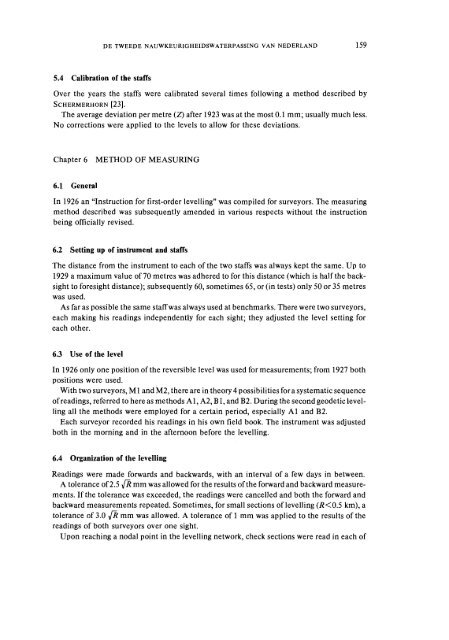+ Download pdf (6.190 kb) - Nederlandse Commissie voor Geodesie
+ Download pdf (6.190 kb) - Nederlandse Commissie voor Geodesie
+ Download pdf (6.190 kb) - Nederlandse Commissie voor Geodesie
You also want an ePaper? Increase the reach of your titles
YUMPU automatically turns print PDFs into web optimized ePapers that Google loves.
DE TWEEDE NAUWKEURIGHEIDSWATERPASSING VAN NEDERLAND<br />
5.4 Calibration of the staffs<br />
Over the years the staffs were calibrated several times following a method described by<br />
SCHERMERHORN [23].<br />
The average deviation per metre (Z) after 1923 was at the most 0.1 mm; usually much less.<br />
No corrections were applied to the levels to allow for these deviations.<br />
Chapter 6 METHOD OF MEASURING<br />
6.1 General<br />
In 1926 an "Instruction for first-order levelling" was compiled for surveyors. The measuring<br />
method described was subsequently amended in various respects without the instruction<br />
being officially revised.<br />
6.2 Setting up of instrument and staffs<br />
The distance from the instrument to each of the two staffs was always kept the same. Up to<br />
1929 a maximum value of 70 metres was adhered to for this distance (which is half the back-<br />
sight to foresight distance); subsequently 60, sometimes 65, or (in tests) only 50 or 35 metres<br />
was used.<br />
As far as possible the same staff was always used at benchmarks. There were two surveyors,<br />
each making his readings independently for each sight; they adjusted the level setting for<br />
each other.<br />
6.3 Use of the level<br />
In 1926 only one position of the reversible level was used for measurements; from 1927 both<br />
positions were used.<br />
With two surveyors, M1 and M2, there are in theory 4 possibilities fora systematic sequence<br />
ofreadings, referred to here as methods Al, A2, B1, and B2. During the second geodetic level-<br />
ling all the methods were employed for a certain period, especially A1 and B2.<br />
Each surveyor recorded his readings in his own field book. The instrument was adjusted<br />
both in the morning and in the afternoon before the levelling.<br />
6.4 Organization of the levelling<br />
Readings were made forwards and backwards, with an interval of a few days in between.<br />
A tolerance of 2.5 ,& mm was allowed for the results of the forward and backward measure-<br />
ments. If the tolerance was exceeded, the readings were cancelled and both the forward and<br />
backward measurements repeated. Sometimes, for small sections of levelling (R
















